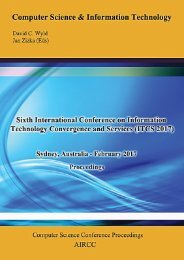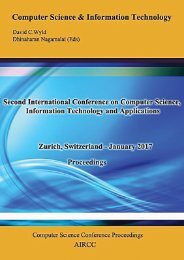CoSIT 2017
Fourth International Conference on Computer Science and Information Technology ( CoSIT 2017 ), Geneva, Switzerland - March 2017
Fourth International Conference on Computer Science and Information Technology ( CoSIT 2017 ), Geneva, Switzerland - March 2017
Create successful ePaper yourself
Turn your PDF publications into a flip-book with our unique Google optimized e-Paper software.
154 Computer Science & Information Technology (CS & IT)<br />
A valid HTML document is composed of three different parts [33]. First, it declares which<br />
version of HTML is used in the document through the document type declaration ().<br />
The document type declaration names the document type definition (DTD) specifying which<br />
elements and attributes can be implemented into a document formatted in HTML [33]. HTML<br />
4.01 specifies three different DTDs: HTML 4.01 Strict DTD; HTML 4.01 Transitional DTD and<br />
HTML 4.01 Frameset DTD [33]. The W3C recommends to use HTML 4.01 Strict DTD which<br />
excludes presentation attributes since these elements are supposed to be replaced by style sheets<br />
[36]. The second part of a HTML document is the document head (). This section<br />
contains information about the current document such as the title and relevant keywords for<br />
search engines. In general, the elements appearing in the head section are not presented by a<br />
document formatted in HTML [33]. The third and most important part of a HTML document is<br />
the body (). This section contains the actual content of the document such as text<br />
paragraphs, images, graphics, tables, links, etc. [33]. The content in the document body can be<br />
structured in many different ways using various HTML elements (tags) to accomplish a certain<br />
look or layout to present the embedded information.<br />
4.2. SEC EDGAR HTML Data<br />
“Official” financial statements filed with the SEC have to be formatted either in American<br />
Standard Code for Information Interchange (ASCII) or in HyperText Markup Language (HTML<br />
3.2/4.0). Financial statements formatted in Portable Document Format (PDF) or XBRL are<br />
considered “unofficial” documents (submissions formatted in PDF and XBRL may qualify as<br />
official documents as well when specific criteria are met) [34]. Due to a limited support of HTML<br />
in order to reduce the number of inconsistencies caused by HTML 4.0 implementation variances<br />
[37], the EDGAR system only accepts a subset of HTML 3.2 semantics (tags) and several HTML<br />
4.0 attributes [34] therefore enforcing several restrictions (no active content, no external<br />
references etc.) of HTML formatting in financial statement submissions [34].The “Complete<br />
Submission Text File” (file extension *.txt) provided by the EDGAR system represents an<br />
aggregation of all information in a particular financial statement filed with the SEC. The text<br />
version of the filings on the SEC server contains the 10-K document formatted in HTML, XBRL,<br />
exhibits and ASCII-encoded graphics (“binary-to-text” encoding or “uuencoding” converts binary<br />
data files to plain ASCII-printable characters to facilitate transfer across various hardware<br />
platforms) [38] [39]. Besides the “Complete Submission Text File” several submission parts<br />
(documents) are also provided in HTML (file extension *.htm) such as the core 10-K document<br />
and the exhibits which have been submitted [38]. For example, Coca Cola´s 10-K filing on<br />
February 25, 2016 lists the core 10-K filing in HTML format, ten exhibits, eight graphic files (file<br />
extension *.jpg), six XBRL files and a single “Complete Submission Text File” containing all of<br />
these documents [40].<br />
5. TEXTUAL INFORMATION IN FINANCIAL STATEMENTS<br />
This section describes how regular expressions are used to extract textual information from<br />
financial statements filed with the SEC. First, I illustrate the fundamentals of regular expressions.<br />
Then I discuss the algorithm to extract textual information from financial statements using only<br />
regular expressions before presenting the actual text embedded in financial statements as a result<br />
of the designed algorithm. Due to their high relevance for investors and researchers an actual<br />
annual report on Form 10-K from the Coca Cola Company serves as basis for the illustration





